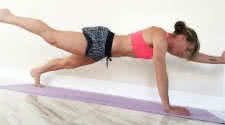Core Curriculum - Tips in your Workout to Strengthen Core

Give each Muscle Group 100% Dedication for Results
Core training doesn't sound sexy but in fact plays an important role for bodybuilders, especially if you train with very heavy weights. Your midsection - your abs and lower back - is the
foundation upon which the rest of your body revolves, at least from a mechanical standpoint. Without a strong midsection you'll never be able to maintain your form on heavy squats,
bent-over rows or deadlifts - movements that really build maximum muscle.
You probably spend a considerable amount of time on ab-training but very little on your lower back. No matter whether you lift weights for strength, performance or simply to look good,
you can't afford to neglect this crucial muscle group.
The lower-back muscles, collectively known as the erector spinae, work with and in opposition to the abdominal muscles. When contracted, the erectors and abs form a natural weight belt
around your entire midsection. This belt serves to protect your spine and provide a rigid attachment point from which other muscle groups can function.
Much like your abs and calves, your erectors are an endurance muscle group that is resistant to fatigue. You have to work them with slightly higher reps to fatigue them sufficiently.
Train your lower back at the end of your workout. Hitting these core trunk muscles early weakens your midsection, thus impacting all movements that follow. Safety becomes an issue as
the risk of injury increases.
Back extensions, good mornings and stiff-leg deadlifts are effective lower-back movements. Some gyms have machines to target this area. Regardless of your method you must include specific
exercises in your routine to strengthen your lower back.
There's more to your body than beach muscles. While the muscles of the lower back aren't highly visible, we can't overstate their importance. Without proper lower-back training you're
trying to build upon a foundation that isn't rock solid.
STRENGTH TO THE CORE
» Do dedicated lower-back exercises at the end of your workout, preferably with back but at least 48 hours before a heavy leg workout.» Do three or four sets of two low-back exercises, and warm up the target muscles as you would any other muscle group. Train in a slightly higher rep range (10-15) with moderate to heavy weights.
» One effective way to train low back is to superset lower-back exercises with abs to train both muscle groups in the least amount of time.
» Always adhere to strict form and perform movements through the full range of motion. Because the lower back is highly vulnerable to disk injury, good form and a controlled rep speed are crucial. Avoid twisting, shaking and jerking motions.
» Keep your low back slightly arched when you do low-back movements. Be careful not to hyper extend the back when doing back extensions. Contrary to their name, hyper-extending the back is not a good idea.